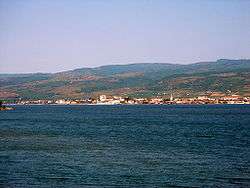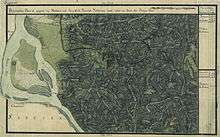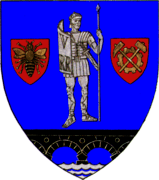Moldova Nouă
| Moldova Nouă | ||
|---|---|---|
| Town | ||
 | ||
| ||
 Moldova Nouă Location of Moldova Nouă | ||
| Coordinates: 44°43′4″N 21°39′50″E / 44.71778°N 21.66389°ECoordinates: 44°43′4″N 21°39′50″E / 44.71778°N 21.66389°E | ||
| Country |
| |
| County | Caraș-Severin County | |
| Status | Town | |
| Government | ||
| • Mayor | Adrian Torma (National Liberal Party) | |
| Area | ||
| • Total | 145.84 km2 (56.31 sq mi) | |
| Population (2011)[1] | ||
| • Total | 12,350 | |
| • Density | 97/km2 (250/sq mi) | |
| Time zone | UTC+2 (EET) | |
| • Summer (DST) | UTC+3 (EEST) | |
| Climate | Cfb | |
| Website | moldovanoua.com | |

Moldova Nouă (Romanian pronunciation: [molˌdova ˈnowə] (![]()
At the 2011 census, 81.2% of inhabitants were Romanians, 12.8% Serbs, 3.2% Roma, 1.3% Hungarians and 0.8% Czechs. At the 2002 census, 88.4% were Romanian Orthodox, 4.5% Baptist, 4% Roman Catholic and 2% Pentecostal.
| In Romanian | In Hungarian | In Serbian |
|---|---|---|
| Moldova Nouă | Újmoldova | Нова Молдава |
| Măcești | Macsevics | Мачевић |
| Moldova Veche | Ómoldova | Стара Молдава |
| Moldovița | Kiskárolyfalva | Молдавица |
| Historical population | ||
|---|---|---|
| Year | Pop. | ±% |
| 1956 | 3,582 | — |
| 1966 | 6,192 | +72.9% |
| 1977 | 15,973 | +158.0% |
| 1992 | 16,874 | +5.6% |
| 2002 | 15,112 | −10.4% |
| 2011 | 12,350 | −18.3% |
| Source: Census data | ||
Moldova Veche
In Moldova Veche village, evidence of human habitation dating to the transition between the Neolithic and the Bronze Age has been found. Additionally, there exist traces of an unfortified Dacian settlement, similar to several others in the area. In Roman Dacia, a castrum located in the village supervised mining and navigation on the Danube. Vestiges from the Dark Ages and the Early Middle Ages have been found; during the 10th and 11th centuries, the area was controlled by Glad and later Ahtum.[2] Serbs have been living there since the Middle Ages.[3]
In 1552, when the Banat fell under Ottoman rule, Moldova Veche became the capital of a sanjak within the Temeşvar Eyalet.[2] In 1566, at the end of Suleiman the Magnificent's reign, coins of gold (altâni) and silver (aspri) were minted there.[4] A document of 1588 records the place under the name Mudava; this is the earliest written mention. The Dacian-origin toponym is still used by locals. In 1718, the area came under the Habsburg Monarchy's control.[2]
The village was absorbed into Moldova Nouă in 1956. It is the site of a Danube port.[5] There is a Baptist church; the community was established in 1927, its first church built in 1967 and the present structure in 2001.[6] Adherents are both Romanian and Serbian, with services conducted in Romanian.[7]
Natives
- Emilijan Josimović, Serbian urbanist
- Iasmin Latovlevici, Romanian footballer
- Mihăiță Pleșan, Romanian footballer
- Clara Vădineanu, Romanian handballer
Notes
- Aleksandra Djurić-Milovanović, "Serbs in Romania: Relationship between Ethnic and Religious Identity", Balcanica XLIII (2012), pp. 117-142
References
| Wikimedia Commons has media related to Moldova Nouă. |
- ↑ (in Romanian) Populația stabilă după etnie - județe, municipii, orașe, comune, National Institute of Statistics; accessed July 25, 2013
- 1 2 3 (in Romanian) Short history at the Moldova Nouă Town Hall site
- ↑ Djurić-Milovanović, p. 120
- ↑ Octavian Iliescu, The History of Coins in Romania (ca. 1500 BC - 2000 AD), p. 48. Bucharest: Editura Enciclopedică, 2002
- ↑ Hinnerk Dreppenstedt, Flusskreuzfahrten Donau, p. 304. Berlin: Trescher Verlag 2017. ISBN 978-389794-373-5
- ↑ (in Romanian) History at the Grace Church site
- ↑ Djurić-Milovanović, p. 128

